Indigenous Cultural Awareness Training Project
VerifiedAdded on 2020/05/28
|17
|3174
|61
AI Summary
This assignment tasks students with developing a comprehensive plan for an Indigenous Cultural Awareness Training Project. It requires identifying potential risks and opportunities, outlining risk mitigation strategies, proposing specific actions to address them, and incorporating previous lessons learned from similar projects. The plan should include elements like communication strategies, resource allocation, and timelines, demonstrating a thorough understanding of project management principles in the context of culturally sensitive training.
Contribute Materials
Your contribution can guide someone’s learning journey. Share your
documents today.
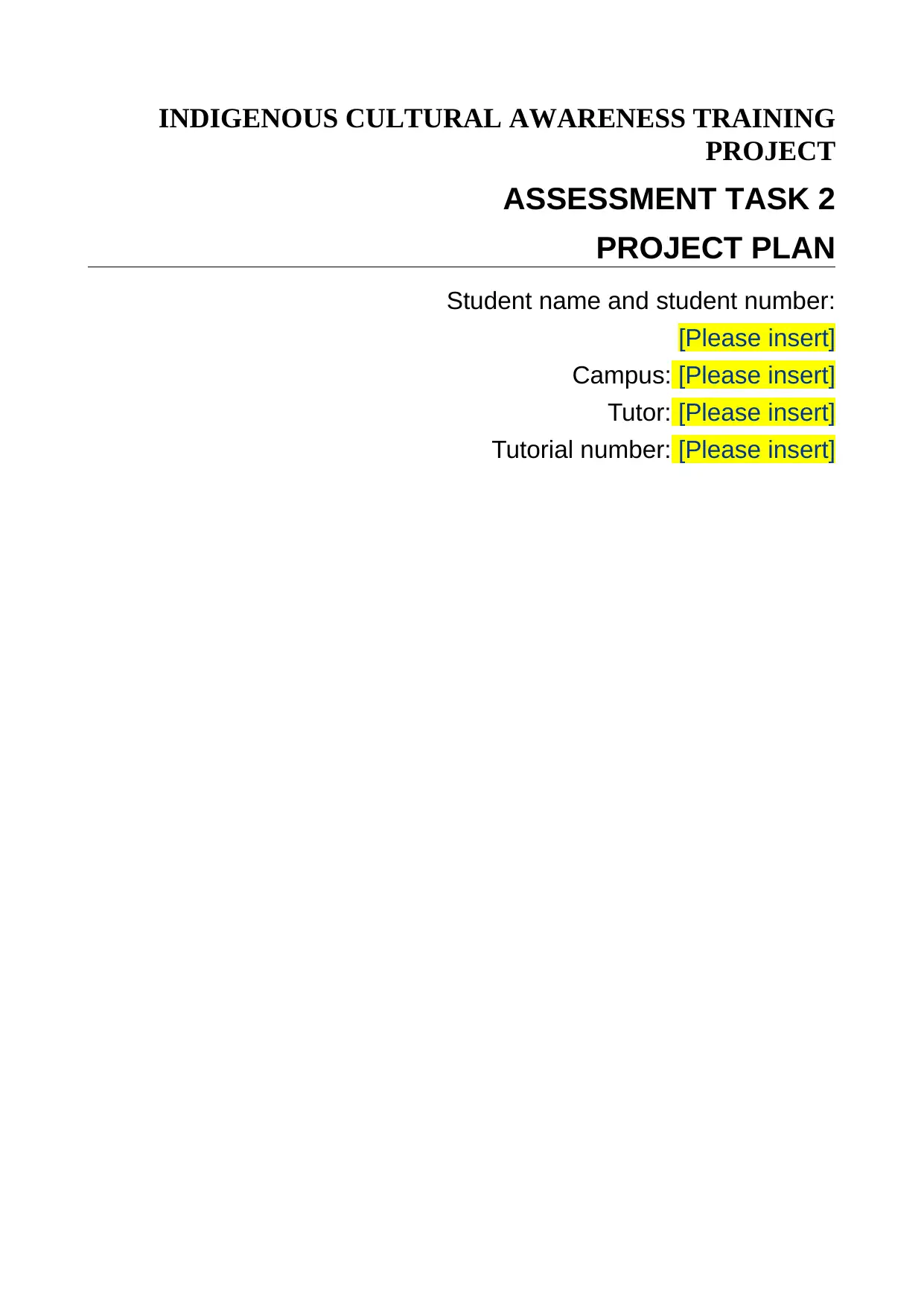
INDIGENOUS CULTURAL AWARENESS TRAINING
PROJECT
ASSESSMENT TASK 2
PROJECT PLAN
Student name and student number:
[Please insert]
Campus: [Please insert]
Tutor: [Please insert]
Tutorial number: [Please insert]
PROJECT
ASSESSMENT TASK 2
PROJECT PLAN
Student name and student number:
[Please insert]
Campus: [Please insert]
Tutor: [Please insert]
Tutorial number: [Please insert]
Secure Best Marks with AI Grader
Need help grading? Try our AI Grader for instant feedback on your assignments.
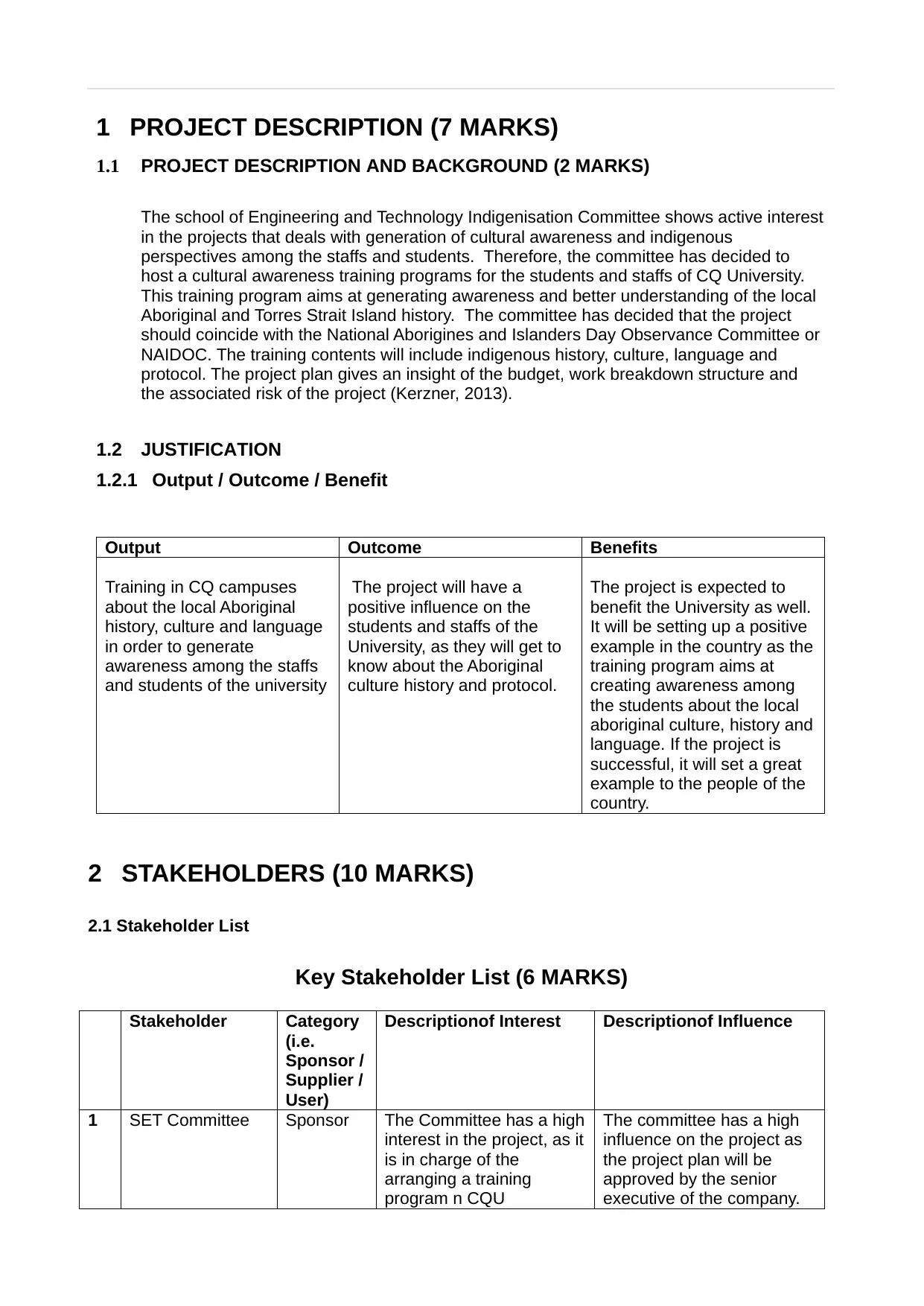
1 PROJECT DESCRIPTION (7 MARKS)
1.1 PROJECT DESCRIPTION AND BACKGROUND (2 MARKS)
The school of Engineering and Technology Indigenisation Committee shows active interest
in the projects that deals with generation of cultural awareness and indigenous
perspectives among the staffs and students. Therefore, the committee has decided to
host a cultural awareness training programs for the students and staffs of CQ University.
This training program aims at generating awareness and better understanding of the local
Aboriginal and Torres Strait Island history. The committee has decided that the project
should coincide with the National Aborigines and Islanders Day Observance Committee or
NAIDOC. The training contents will include indigenous history, culture, language and
protocol. The project plan gives an insight of the budget, work breakdown structure and
the associated risk of the project (Kerzner, 2013).
1.2 JUSTIFICATION
1.2.1 Output / Outcome / Benefit
Output Outcome Benefits
Training in CQ campuses
about the local Aboriginal
history, culture and language
in order to generate
awareness among the staffs
and students of the university
The project will have a
positive influence on the
students and staffs of the
University, as they will get to
know about the Aboriginal
culture history and protocol.
The project is expected to
benefit the University as well.
It will be setting up a positive
example in the country as the
training program aims at
creating awareness among
the students about the local
aboriginal culture, history and
language. If the project is
successful, it will set a great
example to the people of the
country.
2 STAKEHOLDERS (10 MARKS)
2.1 Stakeholder List
Key Stakeholder List (6 MARKS)
Stakeholder Category
(i.e.
Sponsor /
Supplier /
User)
Descriptionof Interest Descriptionof Influence
1 SET Committee Sponsor The Committee has a high
interest in the project, as it
is in charge of the
arranging a training
program n CQU
The committee has a high
influence on the project as
the project plan will be
approved by the senior
executive of the company.
1.1 PROJECT DESCRIPTION AND BACKGROUND (2 MARKS)
The school of Engineering and Technology Indigenisation Committee shows active interest
in the projects that deals with generation of cultural awareness and indigenous
perspectives among the staffs and students. Therefore, the committee has decided to
host a cultural awareness training programs for the students and staffs of CQ University.
This training program aims at generating awareness and better understanding of the local
Aboriginal and Torres Strait Island history. The committee has decided that the project
should coincide with the National Aborigines and Islanders Day Observance Committee or
NAIDOC. The training contents will include indigenous history, culture, language and
protocol. The project plan gives an insight of the budget, work breakdown structure and
the associated risk of the project (Kerzner, 2013).
1.2 JUSTIFICATION
1.2.1 Output / Outcome / Benefit
Output Outcome Benefits
Training in CQ campuses
about the local Aboriginal
history, culture and language
in order to generate
awareness among the staffs
and students of the university
The project will have a
positive influence on the
students and staffs of the
University, as they will get to
know about the Aboriginal
culture history and protocol.
The project is expected to
benefit the University as well.
It will be setting up a positive
example in the country as the
training program aims at
creating awareness among
the students about the local
aboriginal culture, history and
language. If the project is
successful, it will set a great
example to the people of the
country.
2 STAKEHOLDERS (10 MARKS)
2.1 Stakeholder List
Key Stakeholder List (6 MARKS)
Stakeholder Category
(i.e.
Sponsor /
Supplier /
User)
Descriptionof Interest Descriptionof Influence
1 SET Committee Sponsor The Committee has a high
interest in the project, as it
is in charge of the
arranging a training
program n CQU
The committee has a high
influence on the project as
the project plan will be
approved by the senior
executive of the company.
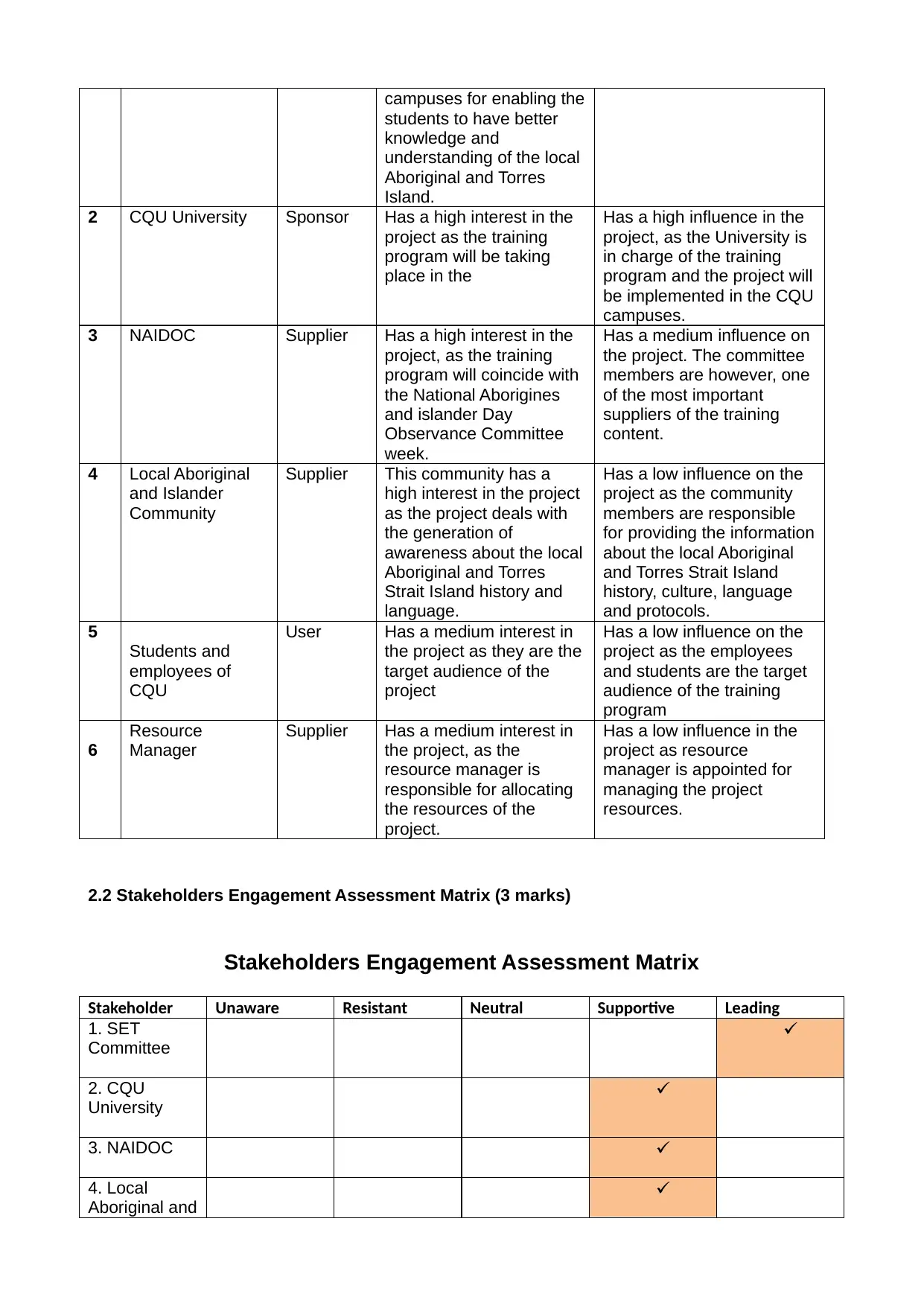
campuses for enabling the
students to have better
knowledge and
understanding of the local
Aboriginal and Torres
Island.
2 CQU University Sponsor Has a high interest in the
project as the training
program will be taking
place in the
Has a high influence in the
project, as the University is
in charge of the training
program and the project will
be implemented in the CQU
campuses.
3 NAIDOC Supplier Has a high interest in the
project, as the training
program will coincide with
the National Aborigines
and islander Day
Observance Committee
week.
Has a medium influence on
the project. The committee
members are however, one
of the most important
suppliers of the training
content.
4 Local Aboriginal
and Islander
Community
Supplier This community has a
high interest in the project
as the project deals with
the generation of
awareness about the local
Aboriginal and Torres
Strait Island history and
language.
Has a low influence on the
project as the community
members are responsible
for providing the information
about the local Aboriginal
and Torres Strait Island
history, culture, language
and protocols.
5
Students and
employees of
CQU
User Has a medium interest in
the project as they are the
target audience of the
project
Has a low influence on the
project as the employees
and students are the target
audience of the training
program
6
Resource
Manager
Supplier Has a medium interest in
the project, as the
resource manager is
responsible for allocating
the resources of the
project.
Has a low influence in the
project as resource
manager is appointed for
managing the project
resources.
2.2 Stakeholders Engagement Assessment Matrix (3 marks)
Stakeholders Engagement Assessment Matrix
Stakeholder Unaware Resistant Neutral Supportive Leading
1. SET
Committee
2. CQU
University
3. NAIDOC
4. Local
Aboriginal and
students to have better
knowledge and
understanding of the local
Aboriginal and Torres
Island.
2 CQU University Sponsor Has a high interest in the
project as the training
program will be taking
place in the
Has a high influence in the
project, as the University is
in charge of the training
program and the project will
be implemented in the CQU
campuses.
3 NAIDOC Supplier Has a high interest in the
project, as the training
program will coincide with
the National Aborigines
and islander Day
Observance Committee
week.
Has a medium influence on
the project. The committee
members are however, one
of the most important
suppliers of the training
content.
4 Local Aboriginal
and Islander
Community
Supplier This community has a
high interest in the project
as the project deals with
the generation of
awareness about the local
Aboriginal and Torres
Strait Island history and
language.
Has a low influence on the
project as the community
members are responsible
for providing the information
about the local Aboriginal
and Torres Strait Island
history, culture, language
and protocols.
5
Students and
employees of
CQU
User Has a medium interest in
the project as they are the
target audience of the
project
Has a low influence on the
project as the employees
and students are the target
audience of the training
program
6
Resource
Manager
Supplier Has a medium interest in
the project, as the
resource manager is
responsible for allocating
the resources of the
project.
Has a low influence in the
project as resource
manager is appointed for
managing the project
resources.
2.2 Stakeholders Engagement Assessment Matrix (3 marks)
Stakeholders Engagement Assessment Matrix
Stakeholder Unaware Resistant Neutral Supportive Leading
1. SET
Committee
2. CQU
University
3. NAIDOC
4. Local
Aboriginal and
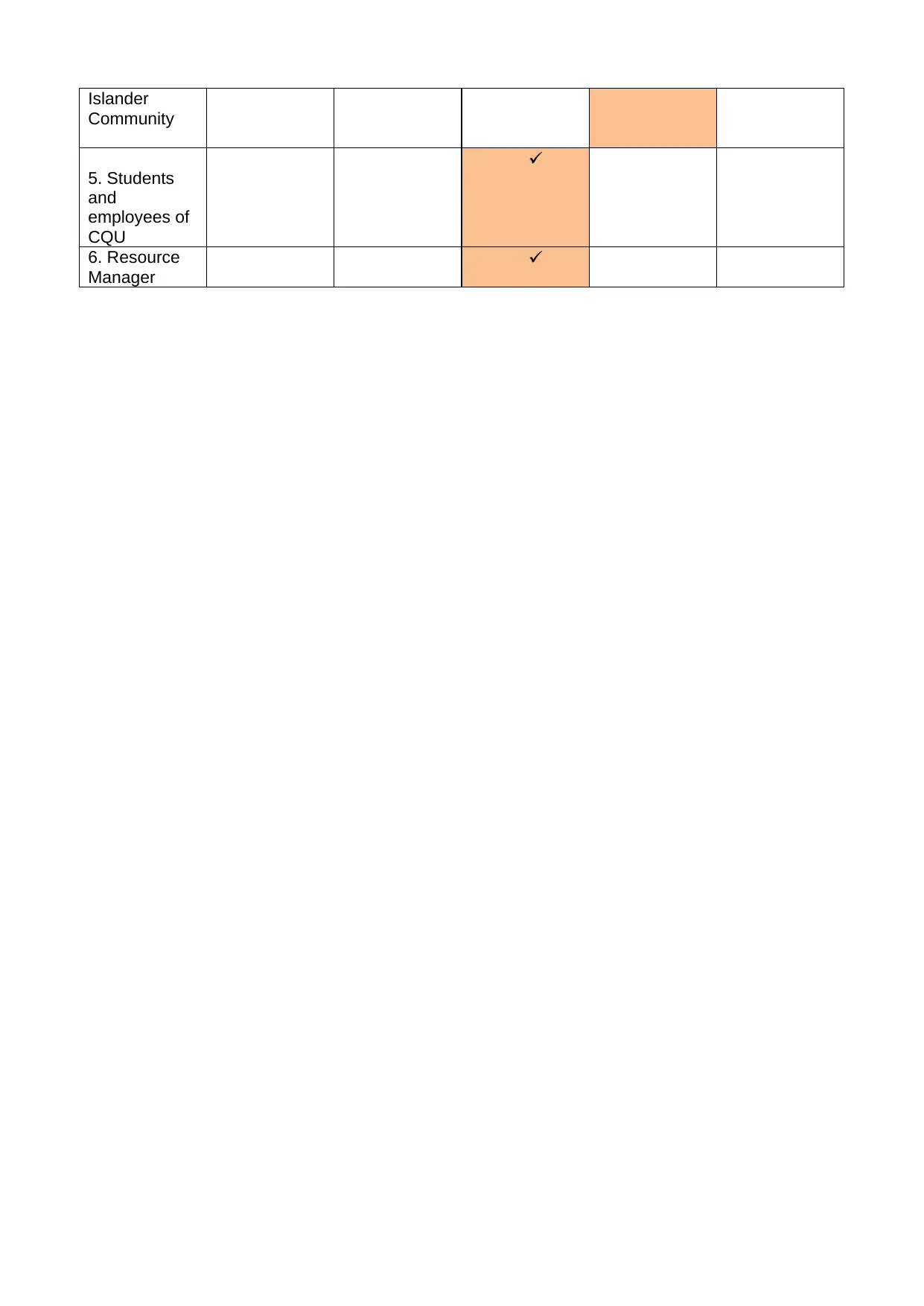
Islander
Community
5. Students
and
employees of
CQU
6. Resource
Manager
Community
5. Students
and
employees of
CQU
6. Resource
Manager
Secure Best Marks with AI Grader
Need help grading? Try our AI Grader for instant feedback on your assignments.
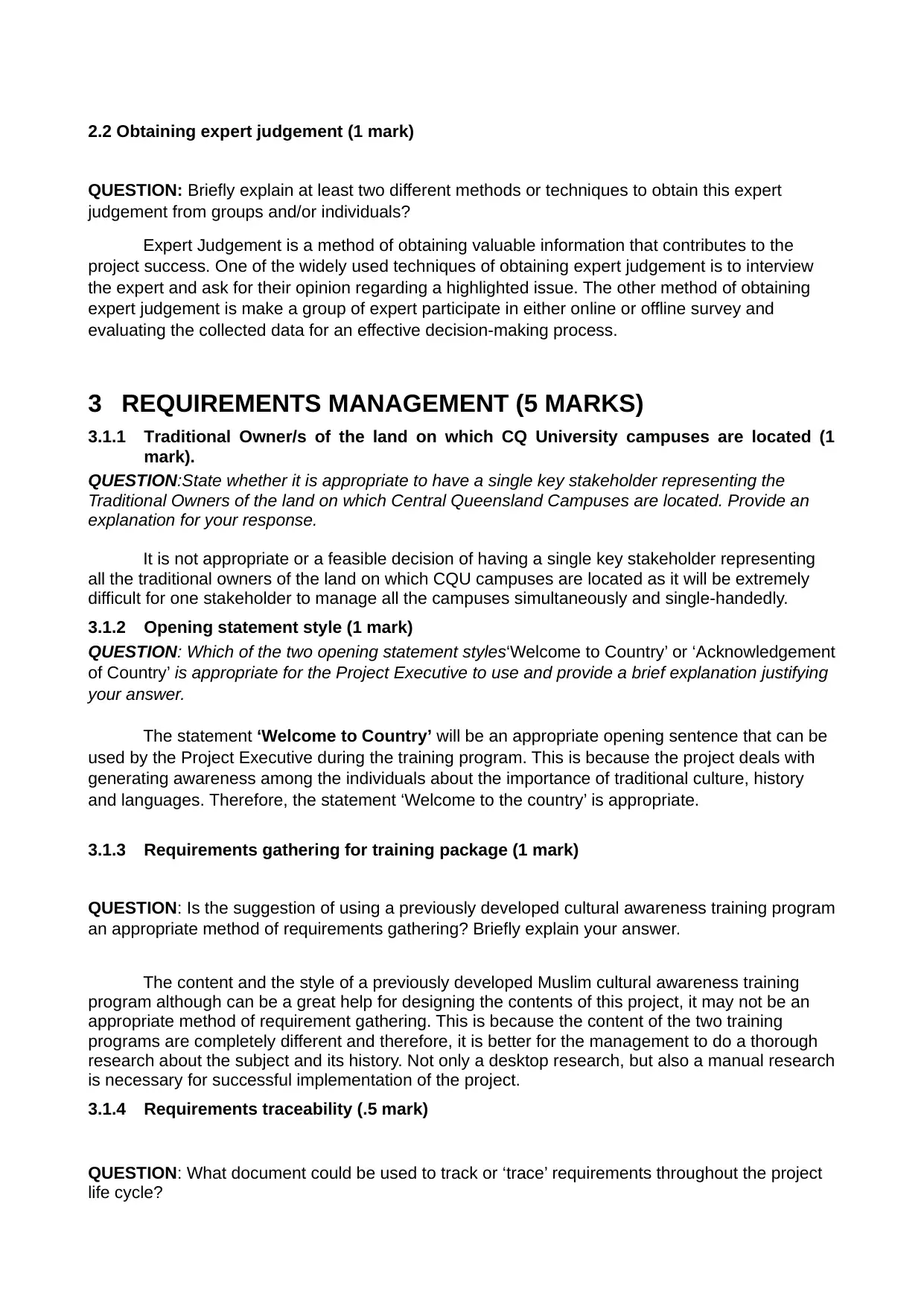
2.2 Obtaining expert judgement (1 mark)
QUESTION: Briefly explain at least two different methods or techniques to obtain this expert
judgement from groups and/or individuals?
Expert Judgement is a method of obtaining valuable information that contributes to the
project success. One of the widely used techniques of obtaining expert judgement is to interview
the expert and ask for their opinion regarding a highlighted issue. The other method of obtaining
expert judgement is make a group of expert participate in either online or offline survey and
evaluating the collected data for an effective decision-making process.
3 REQUIREMENTS MANAGEMENT (5 MARKS)
3.1.1 Traditional Owner/s of the land on which CQ University campuses are located (1
mark).
QUESTION:State whether it is appropriate to have a single key stakeholder representing the
Traditional Owners of the land on which Central Queensland Campuses are located. Provide an
explanation for your response.
It is not appropriate or a feasible decision of having a single key stakeholder representing
all the traditional owners of the land on which CQU campuses are located as it will be extremely
difficult for one stakeholder to manage all the campuses simultaneously and single-handedly.
3.1.2 Opening statement style (1 mark)
QUESTION: Which of the two opening statement styles‘Welcome to Country’ or ‘Acknowledgement
of Country’ is appropriate for the Project Executive to use and provide a brief explanation justifying
your answer.
The statement ‘Welcome to Country’ will be an appropriate opening sentence that can be
used by the Project Executive during the training program. This is because the project deals with
generating awareness among the individuals about the importance of traditional culture, history
and languages. Therefore, the statement ‘Welcome to the country’ is appropriate.
3.1.3 Requirements gathering for training package (1 mark)
QUESTION: Is the suggestion of using a previously developed cultural awareness training program
an appropriate method of requirements gathering? Briefly explain your answer.
The content and the style of a previously developed Muslim cultural awareness training
program although can be a great help for designing the contents of this project, it may not be an
appropriate method of requirement gathering. This is because the content of the two training
programs are completely different and therefore, it is better for the management to do a thorough
research about the subject and its history. Not only a desktop research, but also a manual research
is necessary for successful implementation of the project.
3.1.4 Requirements traceability (.5 mark)
QUESTION: What document could be used to track or ‘trace’ requirements throughout the project
life cycle?
QUESTION: Briefly explain at least two different methods or techniques to obtain this expert
judgement from groups and/or individuals?
Expert Judgement is a method of obtaining valuable information that contributes to the
project success. One of the widely used techniques of obtaining expert judgement is to interview
the expert and ask for their opinion regarding a highlighted issue. The other method of obtaining
expert judgement is make a group of expert participate in either online or offline survey and
evaluating the collected data for an effective decision-making process.
3 REQUIREMENTS MANAGEMENT (5 MARKS)
3.1.1 Traditional Owner/s of the land on which CQ University campuses are located (1
mark).
QUESTION:State whether it is appropriate to have a single key stakeholder representing the
Traditional Owners of the land on which Central Queensland Campuses are located. Provide an
explanation for your response.
It is not appropriate or a feasible decision of having a single key stakeholder representing
all the traditional owners of the land on which CQU campuses are located as it will be extremely
difficult for one stakeholder to manage all the campuses simultaneously and single-handedly.
3.1.2 Opening statement style (1 mark)
QUESTION: Which of the two opening statement styles‘Welcome to Country’ or ‘Acknowledgement
of Country’ is appropriate for the Project Executive to use and provide a brief explanation justifying
your answer.
The statement ‘Welcome to Country’ will be an appropriate opening sentence that can be
used by the Project Executive during the training program. This is because the project deals with
generating awareness among the individuals about the importance of traditional culture, history
and languages. Therefore, the statement ‘Welcome to the country’ is appropriate.
3.1.3 Requirements gathering for training package (1 mark)
QUESTION: Is the suggestion of using a previously developed cultural awareness training program
an appropriate method of requirements gathering? Briefly explain your answer.
The content and the style of a previously developed Muslim cultural awareness training
program although can be a great help for designing the contents of this project, it may not be an
appropriate method of requirement gathering. This is because the content of the two training
programs are completely different and therefore, it is better for the management to do a thorough
research about the subject and its history. Not only a desktop research, but also a manual research
is necessary for successful implementation of the project.
3.1.4 Requirements traceability (.5 mark)
QUESTION: What document could be used to track or ‘trace’ requirements throughout the project
life cycle?
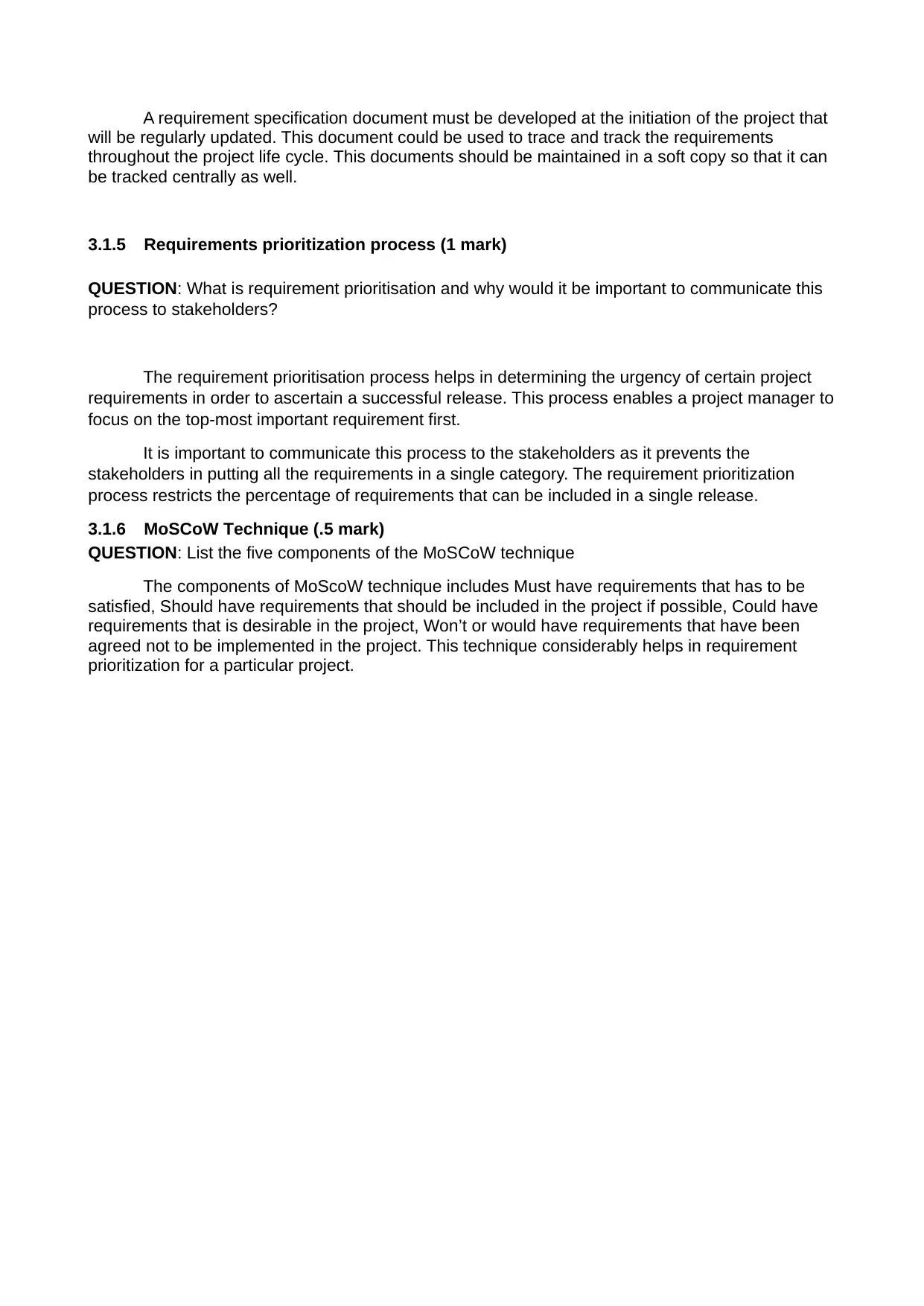
A requirement specification document must be developed at the initiation of the project that
will be regularly updated. This document could be used to trace and track the requirements
throughout the project life cycle. This documents should be maintained in a soft copy so that it can
be tracked centrally as well.
3.1.5 Requirements prioritization process (1 mark)
QUESTION: What is requirement prioritisation and why would it be important to communicate this
process to stakeholders?
The requirement prioritisation process helps in determining the urgency of certain project
requirements in order to ascertain a successful release. This process enables a project manager to
focus on the top-most important requirement first.
It is important to communicate this process to the stakeholders as it prevents the
stakeholders in putting all the requirements in a single category. The requirement prioritization
process restricts the percentage of requirements that can be included in a single release.
3.1.6 MoSCoW Technique (.5 mark)
QUESTION: List the five components of the MoSCoW technique
The components of MoScoW technique includes Must have requirements that has to be
satisfied, Should have requirements that should be included in the project if possible, Could have
requirements that is desirable in the project, Won’t or would have requirements that have been
agreed not to be implemented in the project. This technique considerably helps in requirement
prioritization for a particular project.
will be regularly updated. This document could be used to trace and track the requirements
throughout the project life cycle. This documents should be maintained in a soft copy so that it can
be tracked centrally as well.
3.1.5 Requirements prioritization process (1 mark)
QUESTION: What is requirement prioritisation and why would it be important to communicate this
process to stakeholders?
The requirement prioritisation process helps in determining the urgency of certain project
requirements in order to ascertain a successful release. This process enables a project manager to
focus on the top-most important requirement first.
It is important to communicate this process to the stakeholders as it prevents the
stakeholders in putting all the requirements in a single category. The requirement prioritization
process restricts the percentage of requirements that can be included in a single release.
3.1.6 MoSCoW Technique (.5 mark)
QUESTION: List the five components of the MoSCoW technique
The components of MoScoW technique includes Must have requirements that has to be
satisfied, Should have requirements that should be included in the project if possible, Could have
requirements that is desirable in the project, Won’t or would have requirements that have been
agreed not to be implemented in the project. This technique considerably helps in requirement
prioritization for a particular project.
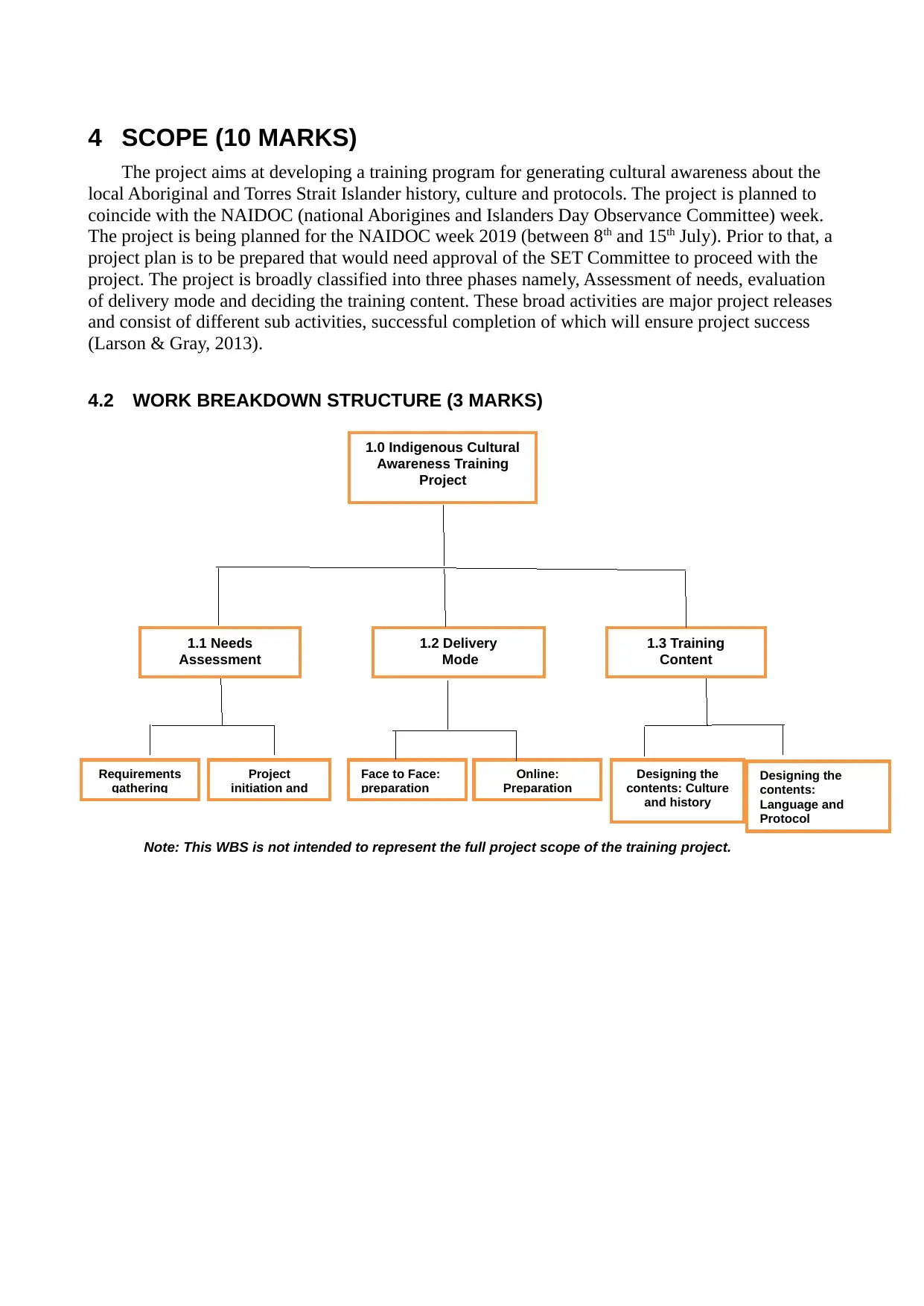
4 SCOPE (10 MARKS)
The project aims at developing a training program for generating cultural awareness about the
local Aboriginal and Torres Strait Islander history, culture and protocols. The project is planned to
coincide with the NAIDOC (national Aborigines and Islanders Day Observance Committee) week.
The project is being planned for the NAIDOC week 2019 (between 8th and 15th July). Prior to that, a
project plan is to be prepared that would need approval of the SET Committee to proceed with the
project. The project is broadly classified into three phases namely, Assessment of needs, evaluation
of delivery mode and deciding the training content. These broad activities are major project releases
and consist of different sub activities, successful completion of which will ensure project success
(Larson & Gray, 2013).
4.2 WORK BREAKDOWN STRUCTURE (3 MARKS)
Note: This WBS is not intended to represent the full project scope of the training project.
1.0 Indigenous Cultural
Awareness Training
Project
1.3 Training
Content
1.2 Delivery
Mode
1.1 Needs
Assessment
Designing the
contents:
Language and
Protocol
Designing the
contents: Culture
and history
Online:
Preparation
Face to Face:
preparation
Project
initiation and
Requirements
gathering
The project aims at developing a training program for generating cultural awareness about the
local Aboriginal and Torres Strait Islander history, culture and protocols. The project is planned to
coincide with the NAIDOC (national Aborigines and Islanders Day Observance Committee) week.
The project is being planned for the NAIDOC week 2019 (between 8th and 15th July). Prior to that, a
project plan is to be prepared that would need approval of the SET Committee to proceed with the
project. The project is broadly classified into three phases namely, Assessment of needs, evaluation
of delivery mode and deciding the training content. These broad activities are major project releases
and consist of different sub activities, successful completion of which will ensure project success
(Larson & Gray, 2013).
4.2 WORK BREAKDOWN STRUCTURE (3 MARKS)
Note: This WBS is not intended to represent the full project scope of the training project.
1.0 Indigenous Cultural
Awareness Training
Project
1.3 Training
Content
1.2 Delivery
Mode
1.1 Needs
Assessment
Designing the
contents:
Language and
Protocol
Designing the
contents: Culture
and history
Online:
Preparation
Face to Face:
preparation
Project
initiation and
Requirements
gathering
Paraphrase This Document
Need a fresh take? Get an instant paraphrase of this document with our AI Paraphraser
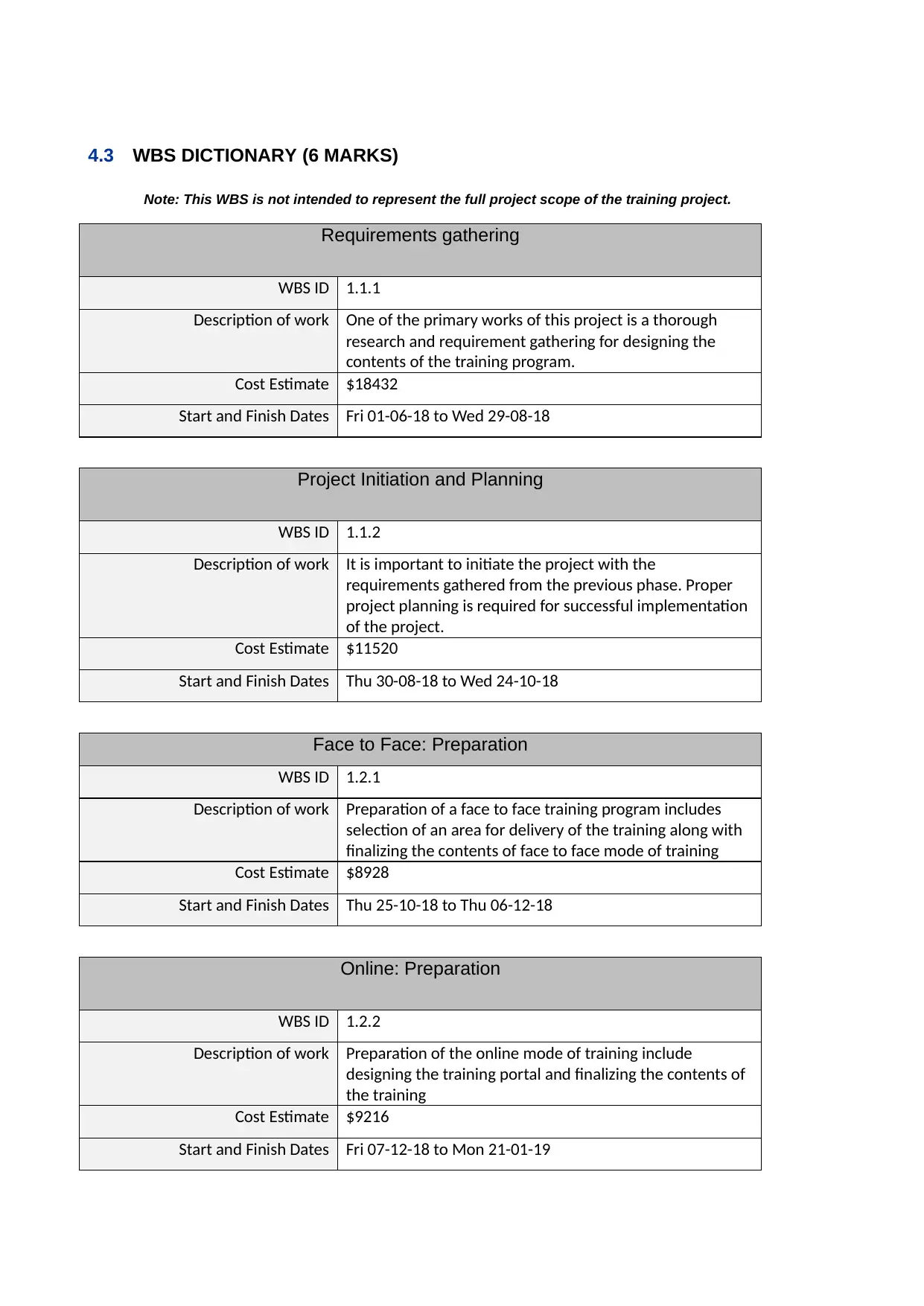
4.3 WBS DICTIONARY (6 MARKS)
Note: This WBS is not intended to represent the full project scope of the training project.
Requirements gathering
WBS ID 1.1.1
Description of work One of the primary works of this project is a thorough
research and requirement gathering for designing the
contents of the training program.
Cost Estimate $18432
Start and Finish Dates Fri 01-06-18 to Wed 29-08-18
Project Initiation and Planning
WBS ID 1.1.2
Description of work It is important to initiate the project with the
requirements gathered from the previous phase. Proper
project planning is required for successful implementation
of the project.
Cost Estimate $11520
Start and Finish Dates Thu 30-08-18 to Wed 24-10-18
Face to Face: Preparation
WBS ID 1.2.1
Description of work Preparation of a face to face training program includes
selection of an area for delivery of the training along with
finalizing the contents of face to face mode of training
Cost Estimate $8928
Start and Finish Dates Thu 25-10-18 to Thu 06-12-18
Online: Preparation
WBS ID 1.2.2
Description of work Preparation of the online mode of training include
designing the training portal and finalizing the contents of
the training
Cost Estimate $9216
Start and Finish Dates Fri 07-12-18 to Mon 21-01-19
Note: This WBS is not intended to represent the full project scope of the training project.
Requirements gathering
WBS ID 1.1.1
Description of work One of the primary works of this project is a thorough
research and requirement gathering for designing the
contents of the training program.
Cost Estimate $18432
Start and Finish Dates Fri 01-06-18 to Wed 29-08-18
Project Initiation and Planning
WBS ID 1.1.2
Description of work It is important to initiate the project with the
requirements gathered from the previous phase. Proper
project planning is required for successful implementation
of the project.
Cost Estimate $11520
Start and Finish Dates Thu 30-08-18 to Wed 24-10-18
Face to Face: Preparation
WBS ID 1.2.1
Description of work Preparation of a face to face training program includes
selection of an area for delivery of the training along with
finalizing the contents of face to face mode of training
Cost Estimate $8928
Start and Finish Dates Thu 25-10-18 to Thu 06-12-18
Online: Preparation
WBS ID 1.2.2
Description of work Preparation of the online mode of training include
designing the training portal and finalizing the contents of
the training
Cost Estimate $9216
Start and Finish Dates Fri 07-12-18 to Mon 21-01-19

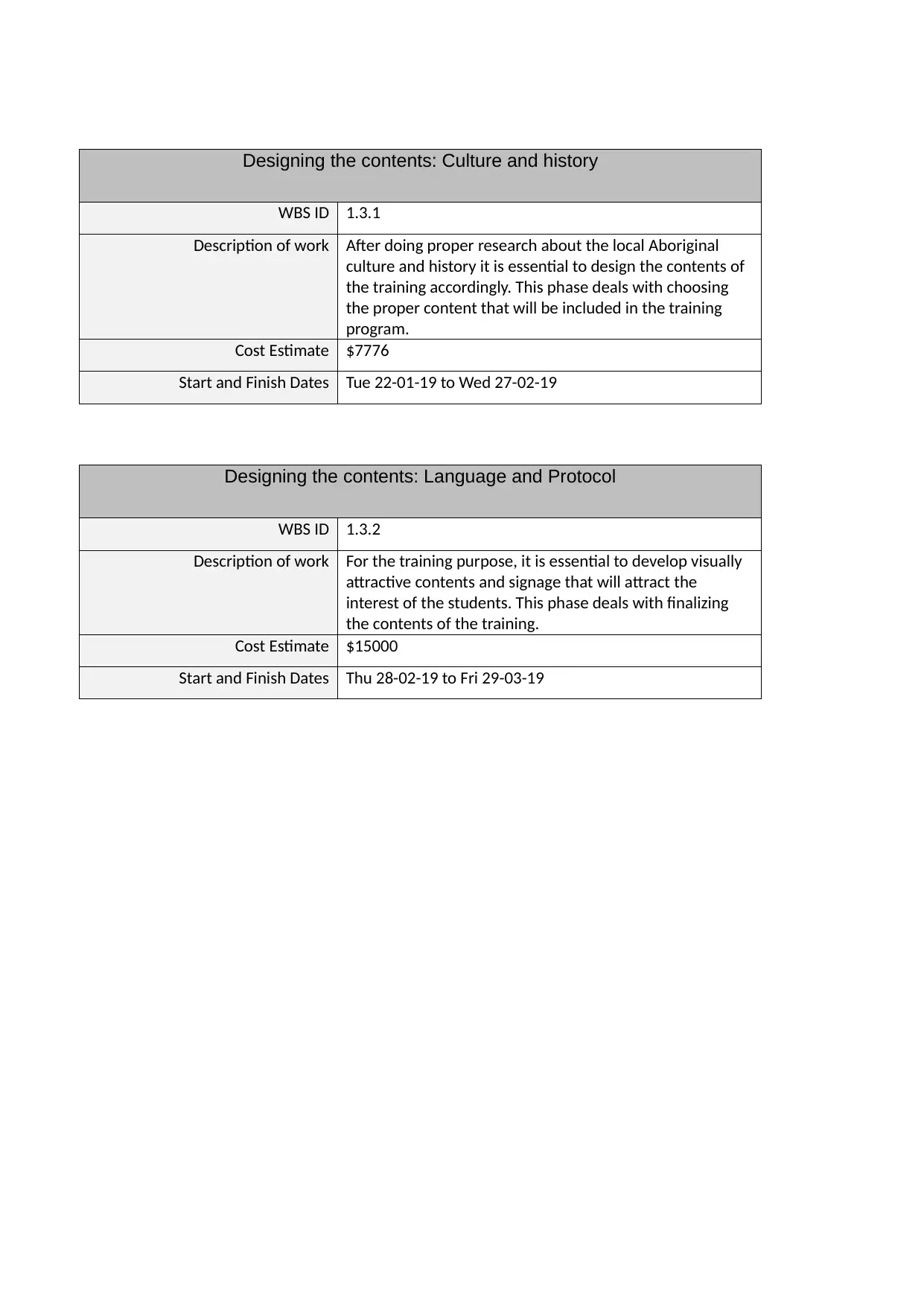
Designing the contents: Culture and history
WBS ID 1.3.1
Description of work After doing proper research about the local Aboriginal
culture and history it is essential to design the contents of
the training accordingly. This phase deals with choosing
the proper content that will be included in the training
program.
Cost Estimate $7776
Start and Finish Dates Tue 22-01-19 to Wed 27-02-19
Designing the contents: Language and Protocol
WBS ID 1.3.2
Description of work For the training purpose, it is essential to develop visually
attractive contents and signage that will attract the
interest of the students. This phase deals with finalizing
the contents of the training.
Cost Estimate $15000
Start and Finish Dates Thu 28-02-19 to Fri 29-03-19
WBS ID 1.3.1
Description of work After doing proper research about the local Aboriginal
culture and history it is essential to design the contents of
the training accordingly. This phase deals with choosing
the proper content that will be included in the training
program.
Cost Estimate $7776
Start and Finish Dates Tue 22-01-19 to Wed 27-02-19
Designing the contents: Language and Protocol
WBS ID 1.3.2
Description of work For the training purpose, it is essential to develop visually
attractive contents and signage that will attract the
interest of the students. This phase deals with finalizing
the contents of the training.
Cost Estimate $15000
Start and Finish Dates Thu 28-02-19 to Fri 29-03-19
Secure Best Marks with AI Grader
Need help grading? Try our AI Grader for instant feedback on your assignments.
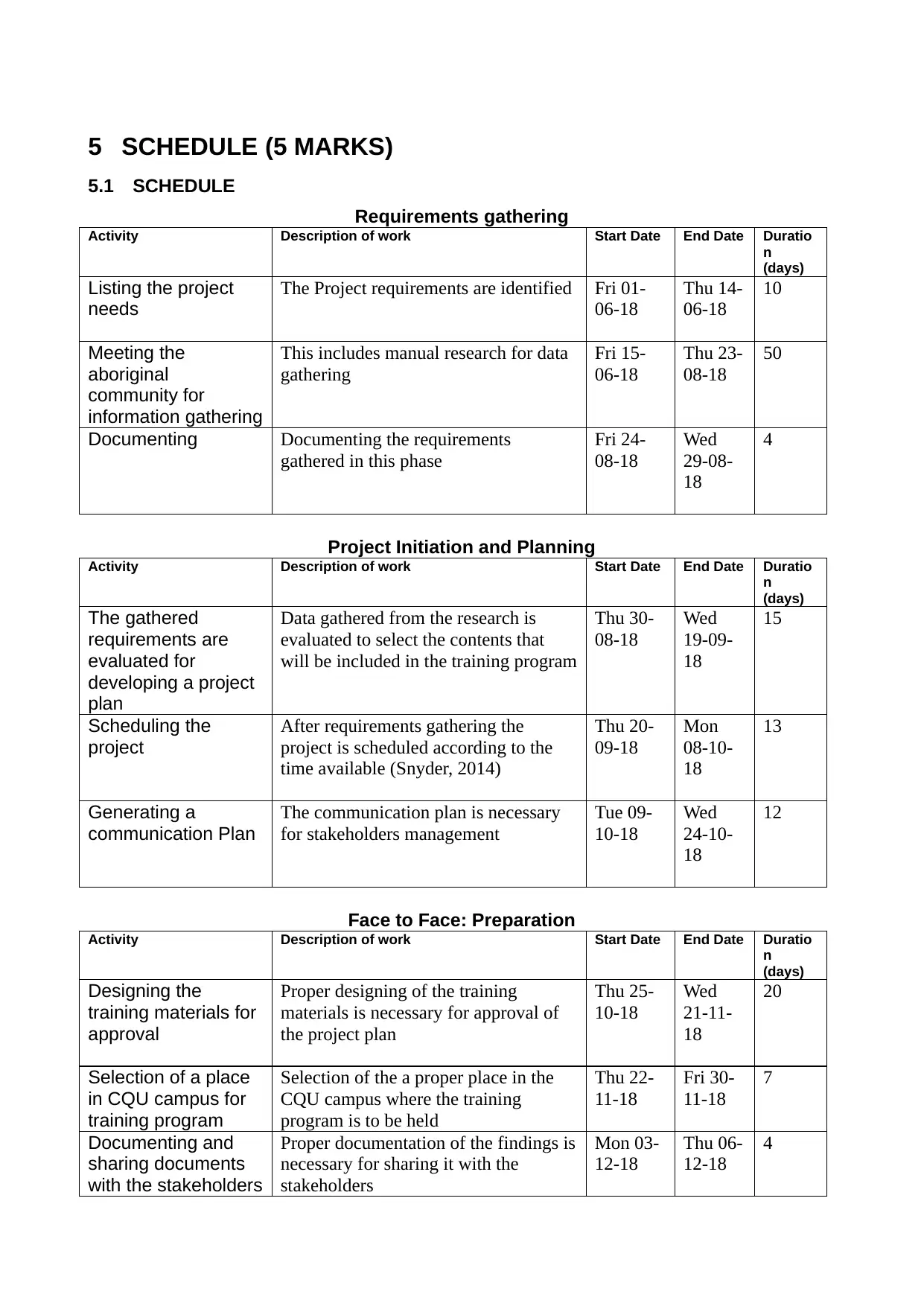
5 SCHEDULE (5 MARKS)
5.1 SCHEDULE
Requirements gathering
Activity Description of work Start Date End Date Duratio
n
(days)
Listing the project
needs
The Project requirements are identified Fri 01-
06-18
Thu 14-
06-18
10
Meeting the
aboriginal
community for
information gathering
This includes manual research for data
gathering
Fri 15-
06-18
Thu 23-
08-18
50
Documenting Documenting the requirements
gathered in this phase
Fri 24-
08-18
Wed
29-08-
18
4
Project Initiation and Planning
Activity Description of work Start Date End Date Duratio
n
(days)
The gathered
requirements are
evaluated for
developing a project
plan
Data gathered from the research is
evaluated to select the contents that
will be included in the training program
Thu 30-
08-18
Wed
19-09-
18
15
Scheduling the
project
After requirements gathering the
project is scheduled according to the
time available (Snyder, 2014)
Thu 20-
09-18
Mon
08-10-
18
13
Generating a
communication Plan
The communication plan is necessary
for stakeholders management
Tue 09-
10-18
Wed
24-10-
18
12
Face to Face: Preparation
Activity Description of work Start Date End Date Duratio
n
(days)
Designing the
training materials for
approval
Proper designing of the training
materials is necessary for approval of
the project plan
Thu 25-
10-18
Wed
21-11-
18
20
Selection of a place
in CQU campus for
training program
Selection of the a proper place in the
CQU campus where the training
program is to be held
Thu 22-
11-18
Fri 30-
11-18
7
Documenting and
sharing documents
with the stakeholders
Proper documentation of the findings is
necessary for sharing it with the
stakeholders
Mon 03-
12-18
Thu 06-
12-18
4
5.1 SCHEDULE
Requirements gathering
Activity Description of work Start Date End Date Duratio
n
(days)
Listing the project
needs
The Project requirements are identified Fri 01-
06-18
Thu 14-
06-18
10
Meeting the
aboriginal
community for
information gathering
This includes manual research for data
gathering
Fri 15-
06-18
Thu 23-
08-18
50
Documenting Documenting the requirements
gathered in this phase
Fri 24-
08-18
Wed
29-08-
18
4
Project Initiation and Planning
Activity Description of work Start Date End Date Duratio
n
(days)
The gathered
requirements are
evaluated for
developing a project
plan
Data gathered from the research is
evaluated to select the contents that
will be included in the training program
Thu 30-
08-18
Wed
19-09-
18
15
Scheduling the
project
After requirements gathering the
project is scheduled according to the
time available (Snyder, 2014)
Thu 20-
09-18
Mon
08-10-
18
13
Generating a
communication Plan
The communication plan is necessary
for stakeholders management
Tue 09-
10-18
Wed
24-10-
18
12
Face to Face: Preparation
Activity Description of work Start Date End Date Duratio
n
(days)
Designing the
training materials for
approval
Proper designing of the training
materials is necessary for approval of
the project plan
Thu 25-
10-18
Wed
21-11-
18
20
Selection of a place
in CQU campus for
training program
Selection of the a proper place in the
CQU campus where the training
program is to be held
Thu 22-
11-18
Fri 30-
11-18
7
Documenting and
sharing documents
with the stakeholders
Proper documentation of the findings is
necessary for sharing it with the
stakeholders
Mon 03-
12-18
Thu 06-
12-18
4
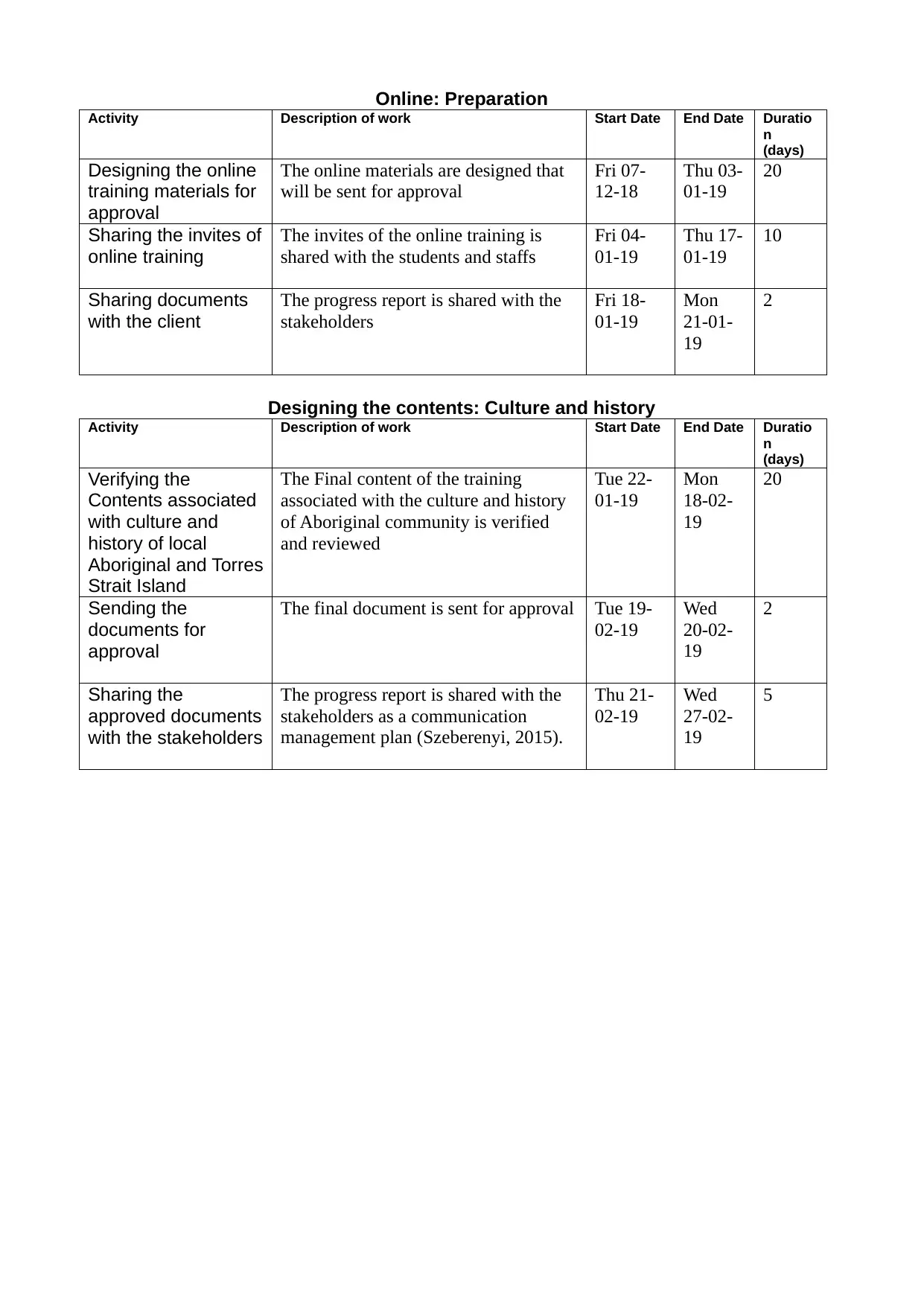
Online: Preparation
Activity Description of work Start Date End Date Duratio
n
(days)
Designing the online
training materials for
approval
The online materials are designed that
will be sent for approval
Fri 07-
12-18
Thu 03-
01-19
20
Sharing the invites of
online training
The invites of the online training is
shared with the students and staffs
Fri 04-
01-19
Thu 17-
01-19
10
Sharing documents
with the client
The progress report is shared with the
stakeholders
Fri 18-
01-19
Mon
21-01-
19
2
Designing the contents: Culture and history
Activity Description of work Start Date End Date Duratio
n
(days)
Verifying the
Contents associated
with culture and
history of local
Aboriginal and Torres
Strait Island
The Final content of the training
associated with the culture and history
of Aboriginal community is verified
and reviewed
Tue 22-
01-19
Mon
18-02-
19
20
Sending the
documents for
approval
The final document is sent for approval Tue 19-
02-19
Wed
20-02-
19
2
Sharing the
approved documents
with the stakeholders
The progress report is shared with the
stakeholders as a communication
management plan (Szeberenyi, 2015).
Thu 21-
02-19
Wed
27-02-
19
5
Activity Description of work Start Date End Date Duratio
n
(days)
Designing the online
training materials for
approval
The online materials are designed that
will be sent for approval
Fri 07-
12-18
Thu 03-
01-19
20
Sharing the invites of
online training
The invites of the online training is
shared with the students and staffs
Fri 04-
01-19
Thu 17-
01-19
10
Sharing documents
with the client
The progress report is shared with the
stakeholders
Fri 18-
01-19
Mon
21-01-
19
2
Designing the contents: Culture and history
Activity Description of work Start Date End Date Duratio
n
(days)
Verifying the
Contents associated
with culture and
history of local
Aboriginal and Torres
Strait Island
The Final content of the training
associated with the culture and history
of Aboriginal community is verified
and reviewed
Tue 22-
01-19
Mon
18-02-
19
20
Sending the
documents for
approval
The final document is sent for approval Tue 19-
02-19
Wed
20-02-
19
2
Sharing the
approved documents
with the stakeholders
The progress report is shared with the
stakeholders as a communication
management plan (Szeberenyi, 2015).
Thu 21-
02-19
Wed
27-02-
19
5
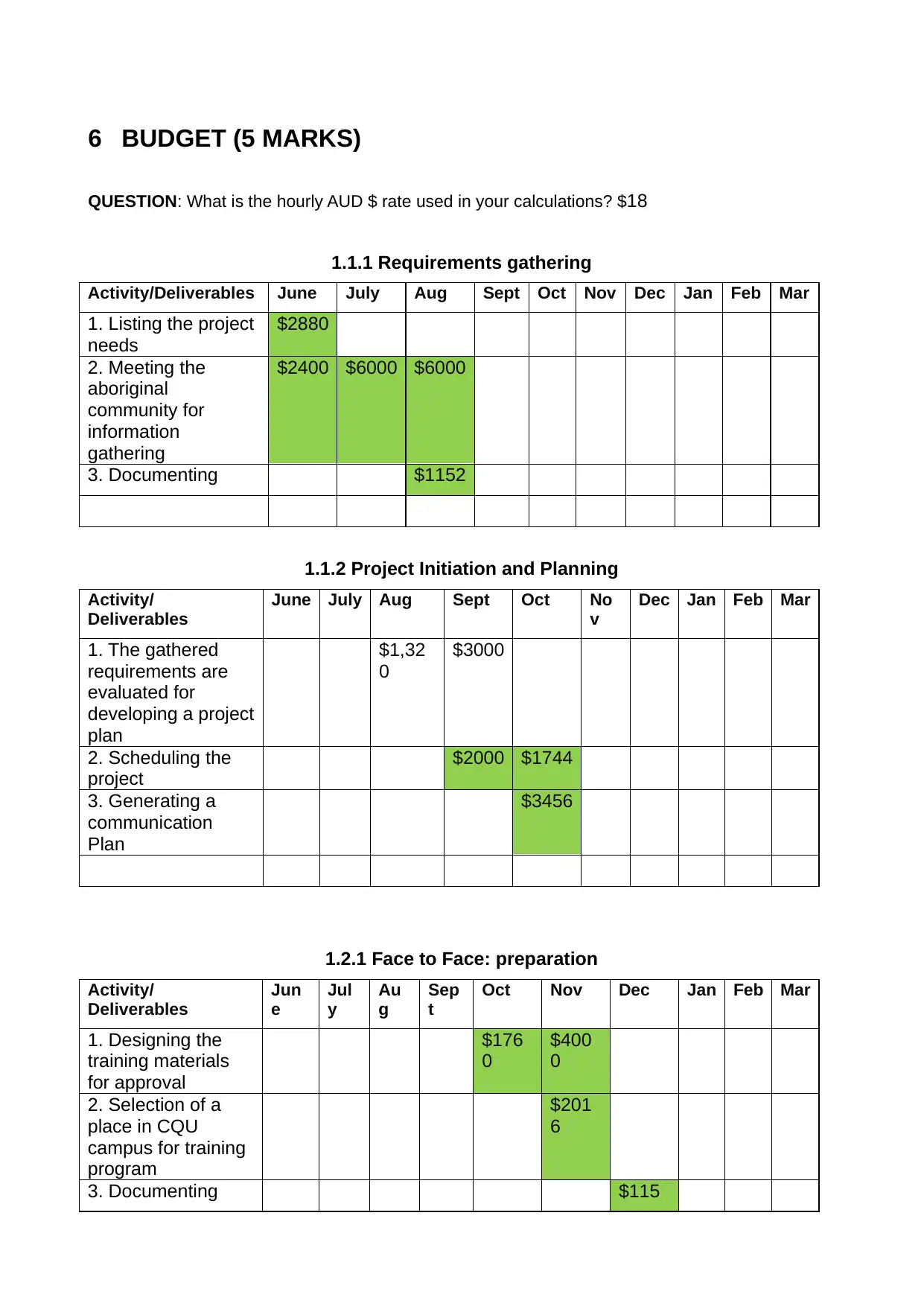
6 BUDGET (5 MARKS)
QUESTION: What is the hourly AUD $ rate used in your calculations? $18
1.1.1 Requirements gathering
Activity/Deliverables June July Aug Sept Oct Nov Dec Jan Feb Mar
1. Listing the project
needs
$2880
2. Meeting the
aboriginal
community for
information
gathering
$2400 $6000 $6000
3. Documenting $1152
1.1.2 Project Initiation and Planning
Activity/
Deliverables
June July Aug Sept Oct No
v
Dec Jan Feb Mar
1. The gathered
requirements are
evaluated for
developing a project
plan
$1,32
0
$3000
2. Scheduling the
project
$2000 $1744
3. Generating a
communication
Plan
$3456
1.2.1 Face to Face: preparation
Activity/
Deliverables
Jun
e
Jul
y
Au
g
Sep
t
Oct Nov Dec Jan Feb Mar
1. Designing the
training materials
for approval
$176
0
$400
0
2. Selection of a
place in CQU
campus for training
program
$201
6
3. Documenting $115
QUESTION: What is the hourly AUD $ rate used in your calculations? $18
1.1.1 Requirements gathering
Activity/Deliverables June July Aug Sept Oct Nov Dec Jan Feb Mar
1. Listing the project
needs
$2880
2. Meeting the
aboriginal
community for
information
gathering
$2400 $6000 $6000
3. Documenting $1152
1.1.2 Project Initiation and Planning
Activity/
Deliverables
June July Aug Sept Oct No
v
Dec Jan Feb Mar
1. The gathered
requirements are
evaluated for
developing a project
plan
$1,32
0
$3000
2. Scheduling the
project
$2000 $1744
3. Generating a
communication
Plan
$3456
1.2.1 Face to Face: preparation
Activity/
Deliverables
Jun
e
Jul
y
Au
g
Sep
t
Oct Nov Dec Jan Feb Mar
1. Designing the
training materials
for approval
$176
0
$400
0
2. Selection of a
place in CQU
campus for training
program
$201
6
3. Documenting $115
Paraphrase This Document
Need a fresh take? Get an instant paraphrase of this document with our AI Paraphraser

and sharing
documents with the
stakeholders
2
documents with the
stakeholders
2
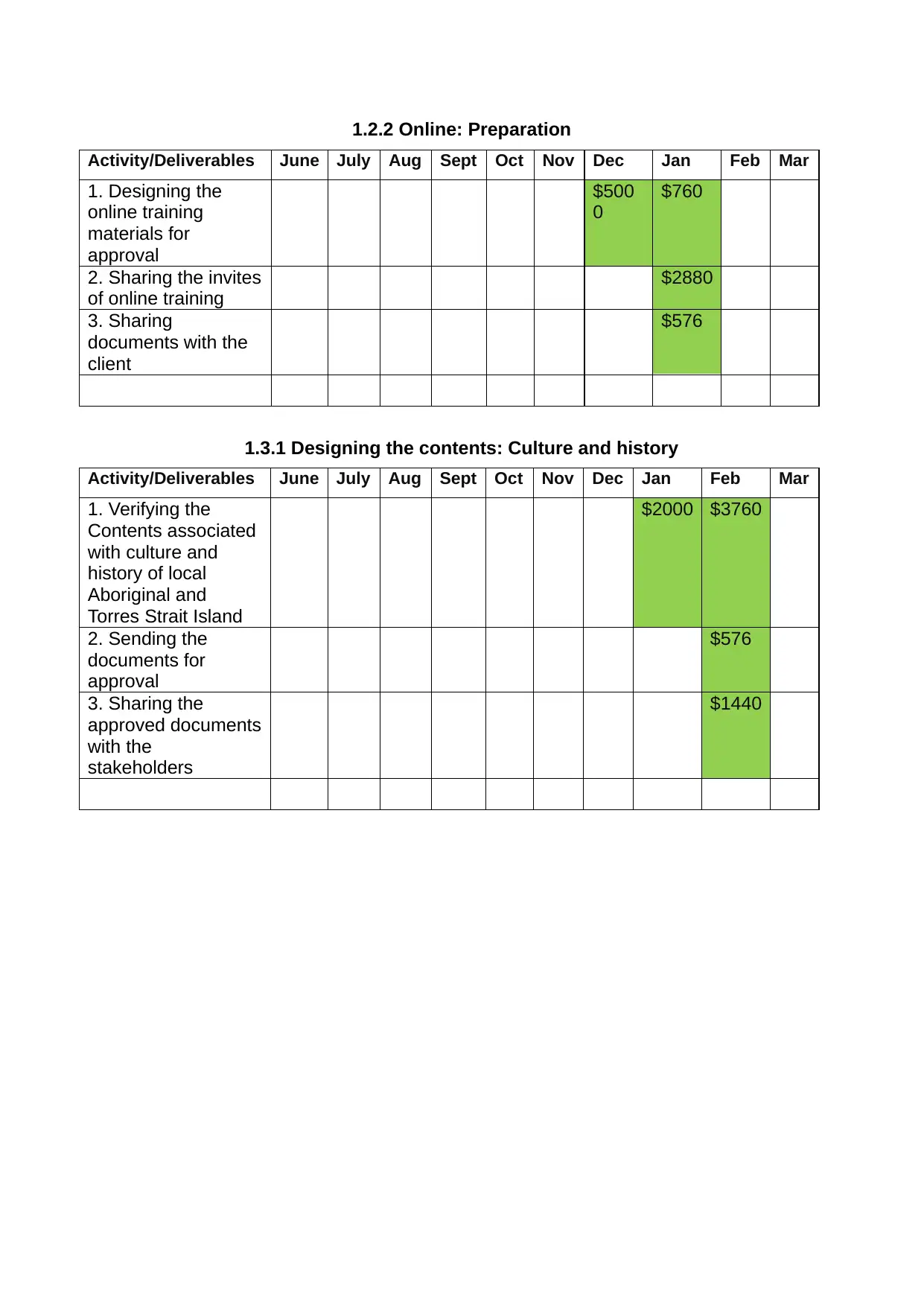
1.2.2 Online: Preparation
Activity/Deliverables June July Aug Sept Oct Nov Dec Jan Feb Mar
1. Designing the
online training
materials for
approval
$500
0
$760
2. Sharing the invites
of online training
$2880
3. Sharing
documents with the
client
$576
1.3.1 Designing the contents: Culture and history
Activity/Deliverables June July Aug Sept Oct Nov Dec Jan Feb Mar
1. Verifying the
Contents associated
with culture and
history of local
Aboriginal and
Torres Strait Island
$2000 $3760
2. Sending the
documents for
approval
$576
3. Sharing the
approved documents
with the
stakeholders
$1440
Activity/Deliverables June July Aug Sept Oct Nov Dec Jan Feb Mar
1. Designing the
online training
materials for
approval
$500
0
$760
2. Sharing the invites
of online training
$2880
3. Sharing
documents with the
client
$576
1.3.1 Designing the contents: Culture and history
Activity/Deliverables June July Aug Sept Oct Nov Dec Jan Feb Mar
1. Verifying the
Contents associated
with culture and
history of local
Aboriginal and
Torres Strait Island
$2000 $3760
2. Sending the
documents for
approval
$576
3. Sharing the
approved documents
with the
stakeholders
$1440
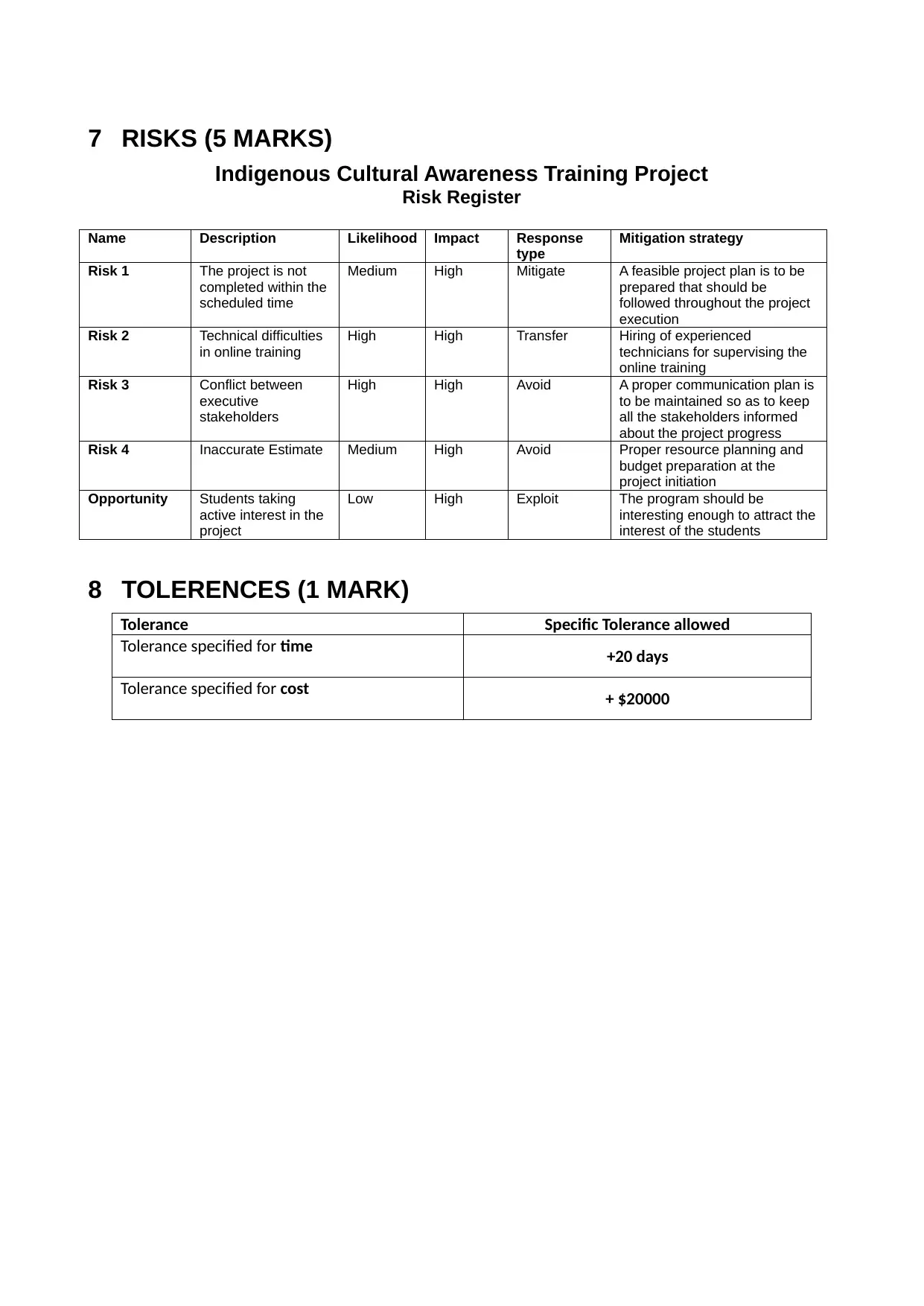
7 RISKS (5 MARKS)
Indigenous Cultural Awareness Training Project
Risk Register
Name Description Likelihood Impact Response
type
Mitigation strategy
Risk 1 The project is not
completed within the
scheduled time
Medium High Mitigate A feasible project plan is to be
prepared that should be
followed throughout the project
execution
Risk 2 Technical difficulties
in online training
High High Transfer Hiring of experienced
technicians for supervising the
online training
Risk 3 Conflict between
executive
stakeholders
High High Avoid A proper communication plan is
to be maintained so as to keep
all the stakeholders informed
about the project progress
Risk 4 Inaccurate Estimate Medium High Avoid Proper resource planning and
budget preparation at the
project initiation
Opportunity Students taking
active interest in the
project
Low High Exploit The program should be
interesting enough to attract the
interest of the students
8 TOLERENCES (1 MARK)
Tolerance Specific Tolerance allowed
Tolerance specified for time +20 days
Tolerance specified for cost + $20000
Indigenous Cultural Awareness Training Project
Risk Register
Name Description Likelihood Impact Response
type
Mitigation strategy
Risk 1 The project is not
completed within the
scheduled time
Medium High Mitigate A feasible project plan is to be
prepared that should be
followed throughout the project
execution
Risk 2 Technical difficulties
in online training
High High Transfer Hiring of experienced
technicians for supervising the
online training
Risk 3 Conflict between
executive
stakeholders
High High Avoid A proper communication plan is
to be maintained so as to keep
all the stakeholders informed
about the project progress
Risk 4 Inaccurate Estimate Medium High Avoid Proper resource planning and
budget preparation at the
project initiation
Opportunity Students taking
active interest in the
project
Low High Exploit The program should be
interesting enough to attract the
interest of the students
8 TOLERENCES (1 MARK)
Tolerance Specific Tolerance allowed
Tolerance specified for time +20 days
Tolerance specified for cost + $20000
Secure Best Marks with AI Grader
Need help grading? Try our AI Grader for instant feedback on your assignments.
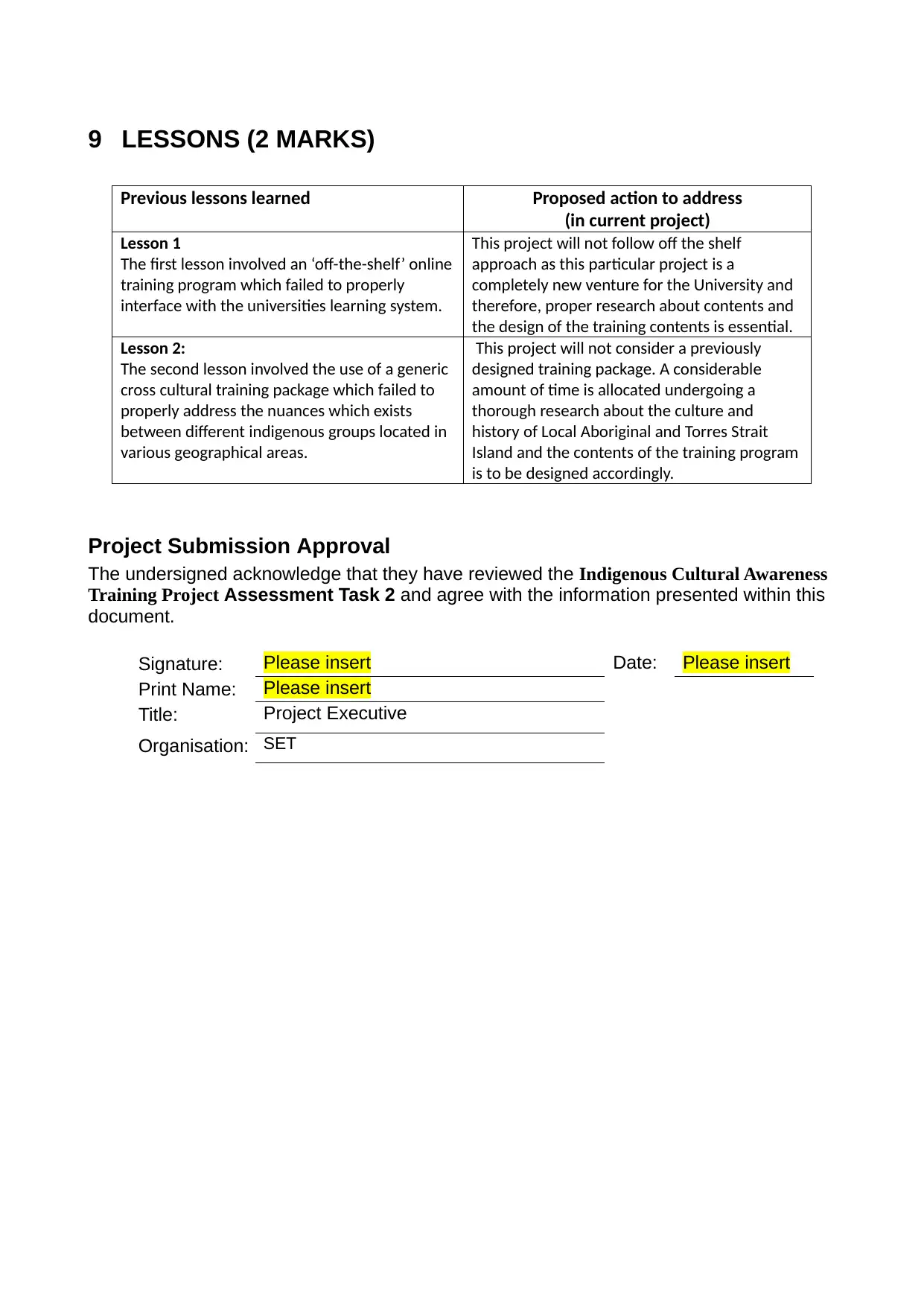
9 LESSONS (2 MARKS)
Previous lessons learned Proposed action to address
(in current project)
Lesson 1
The first lesson involved an ‘off-the-shelf’ online
training program which failed to properly
interface with the universities learning system.
This project will not follow off the shelf
approach as this particular project is a
completely new venture for the University and
therefore, proper research about contents and
the design of the training contents is essential.
Lesson 2:
The second lesson involved the use of a generic
cross cultural training package which failed to
properly address the nuances which exists
between different indigenous groups located in
various geographical areas.
This project will not consider a previously
designed training package. A considerable
amount of time is allocated undergoing a
thorough research about the culture and
history of Local Aboriginal and Torres Strait
Island and the contents of the training program
is to be designed accordingly.
Project Submission Approval
The undersigned acknowledge that they have reviewed the Indigenous Cultural Awareness
Training Project Assessment Task 2 and agree with the information presented within this
document.
Signature: Please insert Date: Please insert
Print Name: Please insert
Title: Project Executive
Organisation: SET
Previous lessons learned Proposed action to address
(in current project)
Lesson 1
The first lesson involved an ‘off-the-shelf’ online
training program which failed to properly
interface with the universities learning system.
This project will not follow off the shelf
approach as this particular project is a
completely new venture for the University and
therefore, proper research about contents and
the design of the training contents is essential.
Lesson 2:
The second lesson involved the use of a generic
cross cultural training package which failed to
properly address the nuances which exists
between different indigenous groups located in
various geographical areas.
This project will not consider a previously
designed training package. A considerable
amount of time is allocated undergoing a
thorough research about the culture and
history of Local Aboriginal and Torres Strait
Island and the contents of the training program
is to be designed accordingly.
Project Submission Approval
The undersigned acknowledge that they have reviewed the Indigenous Cultural Awareness
Training Project Assessment Task 2 and agree with the information presented within this
document.
Signature: Please insert Date: Please insert
Print Name: Please insert
Title: Project Executive
Organisation: SET
1 out of 17
Related Documents
Your All-in-One AI-Powered Toolkit for Academic Success.
+13062052269
info@desklib.com
Available 24*7 on WhatsApp / Email
![[object Object]](/_next/static/media/star-bottom.7253800d.svg)
Unlock your academic potential
© 2024 | Zucol Services PVT LTD | All rights reserved.





